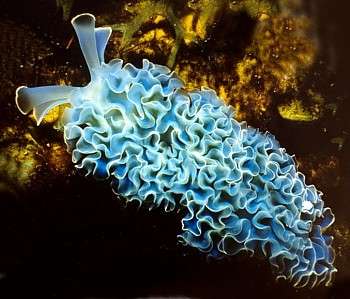
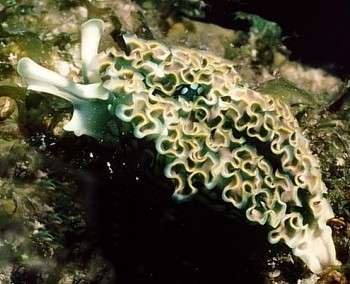
Elysia crispata
(Morch, 1863)
Order: SACOGLOSSA
Superfamily: ELYSIOIDEA
Family: Elysiidae
DISTRIBUTION
Caribbean
PHOTO
Upper right: Blue colour form - off Saba Island, Caribbean. Lower right:
LOWER RIGHT: Green colour form. Note dark green colouration caused by dense populations of symbiotic chloroplasts. Bahamas. Photos: Anne Dupont.
Large elysiid, up to 50 mm long and 30 mm wide with prominent parapodia which are very folded at the edge, with both primary and secondary semipermanent folds. The parapodia on each side fuse just in front of the pericardial hump, to form a barrier between the head and the pericardium. The green colour in E. crispata is much more localised in certain areas of the body than in E. clarki. The dorsal surface between the parapodia of well-fed E. crispata is generally green, interspersed with much larger white spots which, unlike those of E. clarki, often fuse together to form extended areas devoid of green . The head of E. crispata is usually only lightly pigmented with green, sometimes with a diffuse blue band extending between the rhinophores. The sides of the body, between the base of the parapodia and the foot are also green with large white spots in well-fed individuals. The outer edge of the parapodia often has a deep blue band of variable thickness. Along the parapodial edge there can be an orange band, sometimes tending to red. It may be continuous, intermittent or lacking entirely.
The foot is relatively thick, and muscular with distinct lateral edges. It is an opaque white with no green plastids visible in it or within the ventral part of the body covered by the foot. Specimens of E. crispata typically have a narrow blue pigment band running along the edge of the foot.
E. crispata has lecithotrophic larval development [non-feeding planktonic larvae] with veliger larvae metamorphosing into juvenile slugs after about 5 days. Unfortunately the food source for juveniles is unknown. The food of the adults is still problematic but they contain symbiotic plastids from Halimeda incrassata and Penicillus capitatus, but not from any other species of Halimeda or Penicillus, although other species of both genera are present in their natural habitats. The molecular studies indicate the presence of plastids from other algal species in E. crispata as well (Pierce et al, 2006).
Both E. crispata and E. clarki retain living chloroplasts which continue to photosynthesise within the body of the sea slug, providing it with sugars for its own nutrition. See the page on Solar powered sea slugs for further information. The process of taking chloroplasts from algal cells and keeping them has been given the name kleptoplasty
Until recently this species was placed in its own genus Tridachia because of the large folded parapodia, but Gosliner (1995) has argued that this is not only unnecessary, but confuses our understanding of the phylogenetic history of the family. It is better to consider it to be a species of Elysia with a very folded parapodial edge. Elysia crispata is very variable in colour. See photos of a red-lined variety.
Note: This species has been confused with Elysia clarki for many years. See separate message [#16728] comparing the two species. Many messages previously located with the E. crispata have been transferred to E. clarki.
-
Clark, K.B. & Busacca, M. (1978) Feeding specificity and chloroplast retention in four tropical ascoglossa, with a discussion of the extent of chloroplast symbiosis and the evolution of the order. Journal of Molluscan Studies, 44: 272-282, Figs 1-3.
-
Curtis, N. E., Massey, S. E., Schwartz, J. A., Tagihof, H. & Pierce, S. K. (2004) The intracellular, functional chloroplasts in adult Elysia crispata come from several algal species, and are different from those in juvenile slugs. Integrative and Comparative Biology, 44: 686.
-
Gosliner, T.M. (1995) The Genus Thuridilla (Opisthobranchia: Elysiidae) from the Tropical Indo-Pacific, with a Revision of the Phylogeny and Systematics of the Elysiidae. Proceedings of the Californian Academy of Sciences, 49(1):1-54.
-
Jensen, K. (1980) A review of sacoglossan diets, with comparative notes on radular and buccal anatomy. Malacological Review, 13: 55-77.
-
Pierce, S.K., Curtis, N.E., Massey, S.E., Bass, A.L., Karl, S.A. & Finney, C.M. (2006) A morphological and molecular comparison between Elysia crispata and a new species of kleptoplastic sacoglossan sea slug (Gastropoda: Opisthobranchia) from the Florida Keys, USA. Molluscan Research, 26(1): 23-38
-
Taylor, D. (1970) Photosynthesis of symbiotic chloroplasts in Tridachia crispata (Bergh). Comparative Biochemistry and Physiology, 38A: 233-236.
-
Trench, R.K. (1969) Chloroplasts as functional endosymbionts in the mollusc Tridachia crispata (Bergh). Nature, 222: 1071-1072.
ARCHIVE NOTE: An earlier edition of this Fact Sheet [6 December 1999] is available on request.
Authorship detailsRudman, W.B., 2006 (May 30) Elysia crispata (Morch, 1863). [In] Sea Slug Forum. Australian Museum, Sydney. Available from http://www.seaslugforum.net/find/elyscris
Related messages
Lettuce slug behaviour
March 26, 2010
From: Bob Bailey
i bought two lettuce slugs to help keep hair algae under control but all they do is sit in front of a 850 gph koralia circulating power head. i was wondering if this is a sign of coming doom for them or if its a common behavior they have.
Locality: Melbourne, Florida
Bob Bailey
bbailey21@cfl.rr.com
Bailey, R., 2010 (Mar 26) Lettuce slug behaviour. [Message in] Sea Slug Forum. Australian Museum, Sydney. Available from http://www.seaslugforum.net/find/23401Dear Bob,
I guess your slugs are Elysia crispata. It is what I have called a Solar-powered Sea Slug because like a plant it can manufacture at least part of it nutrient requirements from sunlight. Plants have special structures called a chloroplasts in their cells which convert sunlight into sugar, and when the slug eats its food plant it keeps these chloroplasts alive and functioning. If you look at the other messages attached to the Elysia crispata Fact Sheet you will find more information on these fascinating animals.
One of these messages [#17626] describe how juveniles stay by aquarium lights for weeks on end, only moving further afield when they mature. I guess they are mimicking their natural behaviour of 'basking' in sunlight so their stolen chloroplasts can photosynthesise.
Best wishes,
Bill Rudman
Two Elysia crispata from Saba, Windward Islands
March 26, 2010
From: Eric Kaye
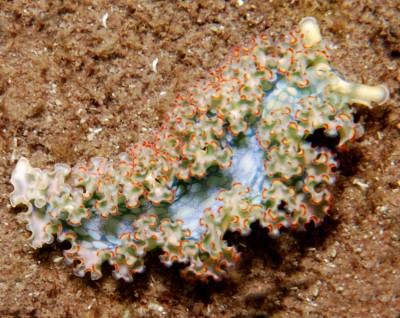
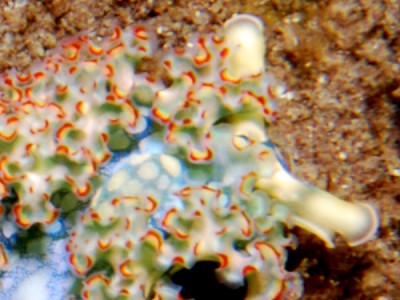
Although the most common sea slug in the Caribbean, I thought these two Elysia crispata were particularly colorful.
Locality: Reef, 30-40 feet, Saba, Windward Islands, Caribbean Sea, 18 March 2010. Length: 2-3 cm. Photographer: Eric Kaye.
Eric Kaye
ek@erickaye.com
Kaye, Eric, 2010 (Mar 26) Two Elysia crispata from Saba, Windward Islands. [Message in] Sea Slug Forum. Australian Museum, Sydney. Available from http://www.seaslugforum.net/find/23397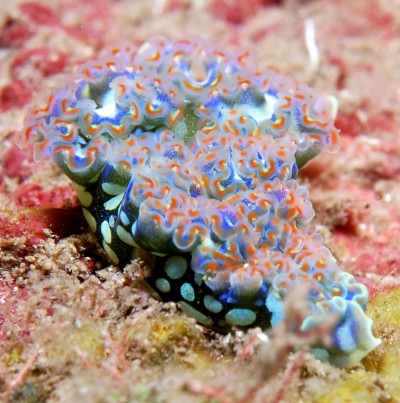
Thanks Eric,
I don't think I have seen one as bright as the one alongside. I have included a close-up of the head end which shows the parapodial flaps on each side of the body join at the anterior end, which is a sure sign that this is E. crispata and not E. clarki.
Best wishes,
Bill Rudman
Colour variations of Elysia crispata from Guadeloupe [2]
November 21, 2007
From: Hugues Flodrops
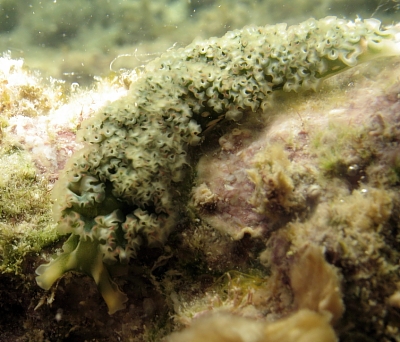
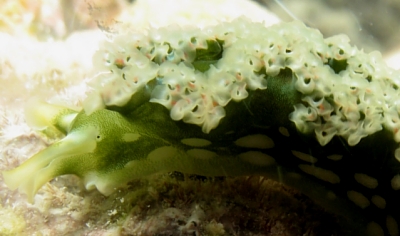
Dear Bill,
To complement my preceding message [#21159] here are photos of a second animal of Elysia crispata.
Locality: Ilot Gosier, 1 metre, Guadeloupe Island, Mer des Antilles, 7 and 10 November 2007. Length: 30 - 35 mm. Photographer: Hugues Flodrops.
Best wishes.
Hugues.
hugues.flodrops@wanadoo.fr
Flodrops,H., 2007 (Nov 21) Colour variations of Elysia crispata from Guadeloupe [2]. [Message in] Sea Slug Forum. Australian Museum, Sydney. Available from http://www.seaslugforum.net/find/21160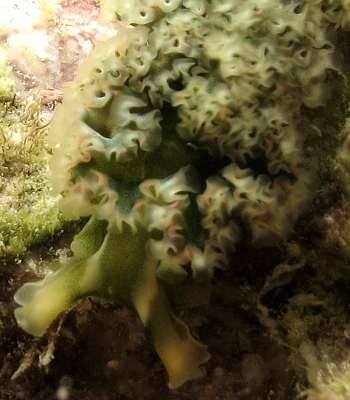
Thanks Hugues,
In this animal it seems pretty clear the parapodia are joined anteriorly and the edge of the parapodia are highly folded, as is typical in E. crispata.
Best wishes,
Bill Rudman
Colour variations of Elysia crispata from Guadeloupe [1]
November 21, 2007
From: Hugues Flodrops
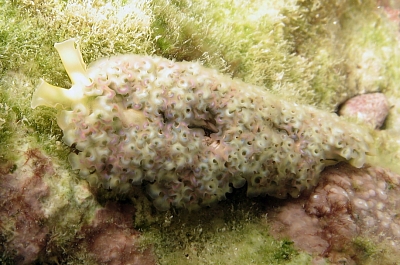
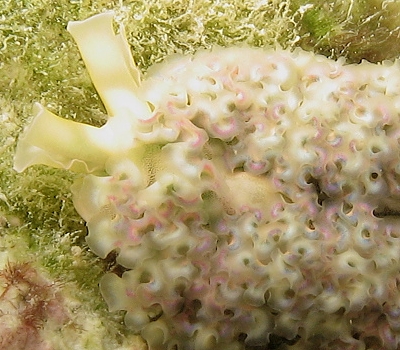
Dear Bill,
Here are some pictures from my recent travel in Guadeloupe. I found more than ten specimens of Elysia crispata from the same area "Ilot Gosier".
Here are some photos of one specimen. I have sent similar photos of a second specimen in a second message [#21160].
Locality: Ilot Gosier, 1 metre, Guadeloupe Island, Mer des Antilles, 7 and 10 November 2007. Length: 30 - 35 mm. Photographer: Hugues Flodrops.
Thanks for your forum, once again.
Best regards.
Hugues.
hugues.flodrops@wanadoo.fr
Flodrops,H., 2007 (Nov 21) Colour variations of Elysia crispata from Guadeloupe [1]. [Message in] Sea Slug Forum. Australian Museum, Sydney. Available from http://www.seaslugforum.net/find/21159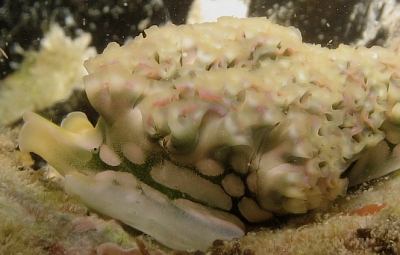
Dear Hugues,
Thanks for these photos. The easiest external characters to separate E. crispata and E. clarki are the lack of green chloroplasts in the sole of the foot in E. crispata and the fusing of the front end of the parapodia in that species. In your middle photo the parapodia seem to be fused, and in the lower photo the sole of the foot lacks green chloroplasts. A third character of E. crispata is that the parapodia have extensive secondary and tertiary folding along the edge. Although this is more difficult to quantify, I would say that your animal definitely fits into the E. crispatarange.
Best wishes,
Bill Rudman
Elysia with a ripped body
October 4, 2007
From: Patrick
So I have an atlantic lettuce slug...and he apparently slid over something, and ripped through his body in his mid section. It did not tear to the tail end, but there is a huge gap in the middle of his body. Will this heal on it's own? Is there anything I can do to speed the healing?
Thank you
Patrick
prk22@pitt.edu
Patrick, 2007 (Oct 4) Elysia with a ripped body. [Message in] Sea Slug Forum. Australian Museum, Sydney. Available from http://www.seaslugforum.net/find/20888Dear Patrick,
I may be a slug doctor in the 'academic sense' but definitely not in the 'medical sense', so any advice I give on caring for sick slugs comes with no guarantee. From anecdotal evidence, sea slugs have quite amazing powers of self-repair so I suspect your Elysia crispata should be able to mend itself without too much bother - as long as it keeps away from whatever is cutting it up.
Best wishes,
Bill Rudman
Location of Elysia crispata - and other slugs?
September 22, 2007
From: Paul Jones
Dear Dr. Rudman,
I am an organic chemist studying the photochemistry of some metabolites isolated from various sacoglossan molluscs. I'm interested in collecting some samples of Elysia crispata (or, perhaps, others). I collected several samples of Plakobranchus ocellatus in Hawaii two years ago on a trip with a friend who is a natural products chemist. I would like to compare these to E. crispata but he has little experience in the Caribbean where, as I understand it, E. crispata is found. I'm hoping to learn where, specifically, one might find these slugs. I'm not a biologist so I'm not sure if there is an etiquette - I don't wish to horn in on someone's territory (if such exists). I have a good deal of snorkeling experience and limited scuba experience. If you or anyone on the forum could point me to a site with a good chance of finding E. crispata, I'd be very grateful.
Some on the forum may be interested in these articles we've published:
-
Zuidema, D.R.; Jones, P.B. (2006) Triplet Photosensitization in Cyercene A and Related Pyrones. J. Photochem. Photobiol. B: Biology, 83: 137-145.
-
Zuidema, D.R.; Miller, A.K.; Trauner, D.; Jones, P.B. (2005) Photosensitized Conversion of 9,10-Deoxytridachione to Photodeoxytridachione. Org. Lett. 7: 4959-4962.
-
Zuidema, D.R.; Jones, P.B. (2005) Photochemical Relationships in Sacoglossan Polypropionates. J. Nat. Prod., 68: 481-486.
Cheers,
Paul Jones
Dept. of Chemistry
Wake Forest University
Winston-Salem, NC 27109
www.wfu.edu/~jonespb
jonespb@wfu.edu
Jones, P.B., 2007 (Sep 22) Location of Elysia crispata - and other slugs?. [Message in] Sea Slug Forum. Australian Museum, Sydney. Available from http://www.seaslugforum.net/find/20769Dear Paul,
If you look at the recent messages on the Forum concerning E. crispata and E. clarki the most obvious source of information would be Prof. Skip Pierce, but I sure there are others who will no doubt contact you.
Best wishes,
Bill Rudman
Elysia crispata? from Cuba
March 23, 2007
From: Simon Crawford
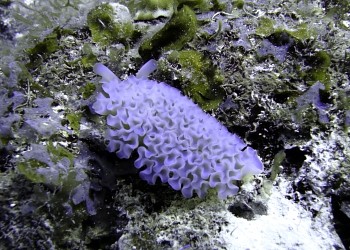
I snapped this little critter off the Isla De La Juventud, Cuba and have struggled to identify it. Can anyone help?
Locality: Isla De La Juventud, circa 12m, Cuba, Carribean, Late October 2006, Coral reef. Length: approx 5cm. Photographer: Simon Crawford.
Best regards,
Simon
scrawford77@hotmail.com
Crawford, S., 2007 (Mar 23) Elysia crispata? from Cuba. [Message in] Sea Slug Forum. Australian Museum, Sydney. Available from http://www.seaslugforum.net/find/19716Dear Simon,
From the very folded edge of the parapodia, I would say this is probably Elysia crispata, but we would need a higher resolution scan, showing the front of the body more clearly to be sure.
Best wishes,
Bill Rudman
Re: Update on Elysia crispata feeding
August 30, 2006
From: Andrew Rodenbeck
Concerning message #13716:
This thread has not been updated in a while, but it seems that there may still be confusion on eating habits of Elysia crispata.
My family now has third generation Elysia crispata in various home aquaria. I know they are at least third generation because the eggs of the original animal were transferred to a new tank. Eggs laid by Elysia crispata in the second tank where transferred to a third aquarium to hatch and grow.
I have observed the adults eat Bryopsis in large quantities. This seems to be the preferred food. But they also eat Chaetomorpha as well as Caulerpa racemosa, Caulerpa taxifolia, Caulerpa serrulata, and several other varieties of Caulerpa (I don't know the scientific names off-hand). Caulerpa is only eaten as a last resort if the preferred food is not found. Juvenile slugs however only ate Bryopsis or Chaetomorpha. They could be raised to maturity on either exclusively.
I am also surprised that the experiments did not carry through to multiple generations because my Elysia crispata were adult size two months after hatching if given access to either Bryopsis or Chaetomorpha and good lighting. The fastest growing slugs were kept in a vertical refugium full of Chaetomorpha with a 28 W compact fluorescent hanging on the side. They would voluntarily remain directly beside the light so that they were only a few cm from the bulb for weeks at a time while growing. Once they reached about 4 cm in length they began to move about much more actively.
Drew
Fort Wayne, Indiana
andrew.rodenbeck@gmail.com
Rodenbeck, A., 2006 (Aug 30) Re: Update on Elysia crispata feeding. [Message in] Sea Slug Forum. Australian Museum, Sydney. Available from http://www.seaslugforum.net/find/17626Dear Drew,
Thanks for the information. I am sure it will be of interest to those studying this fascinating animal. One thing that would be useful is if you could confirm the identity of your Elysia. Many of the animals previously identified as E. crispata have been shown to be a separate species which has been named Elysia clarki. Have a look at that Fact Sheet for links to a comparison between the species. Perhaps you have a photo you could send?
Best wishes,
Bill Rudman
Damaged Elysia crispata
August 28, 2006
From: D. Rose
My lettuce "nudibranch" [Elysia crispata ] must have gotten caught in a powerhead as its back half is missing but it's still alive and moving around. Can it survive this damage? Will it regrow its back end?
D. Rose
RoseDM13@aol.com
Rose, D., 2006 (Aug 28) Damaged Elysia crispata. [Message in] Sea Slug Forum. Australian Museum, Sydney. Available from http://www.seaslugforum.net/find/17549Dear D. Rose,
We know very little about regeneration of lost parts by sea slugs so I would be very interested to hear what happens. I suspect your slug will survive and regrow its back half quite quickly. If you could take a photo of it now so we know what it looks like damaged, and them perhaps a photo every now and then as it regrows and send them to the Forum, you would be providing us with some interesting new informaton. You would need to keep a record of the date you took the photos so we would have some idea how fast it regrows.
Good Luck
Bill Rudman
Re: Update on Elysia crispata feeding
May 6, 2005
From: Colin Finney
Dr Jensen [message #13696] may be over-extending Ms Holm's results [message #13687]. Suggesting that Elysia crispata feed on Caulerpa verticilliata based on Ms Holm's results is problematic for two reasons.
1) The numbers are fairly small but two out of the five controls in Ms Holm's experiments survived the full course of the experiment. One out of five E. crispata in the container with C. verticilliata survived. So starved E. crispata survived better than those given access to C. verticilliata.
2) Ms Holm's C. verticilliata culture may also have contained amphipods which were probably the source of the faecal pellets. At the time she pointed out the faecal pellets to me I established another culture of E. crispata and C. verticillata without amphipods and there was no indication of faecal pellets in this culture.
Colin Finney
University of the Virgin Islands
cfinney@uvi.edu
Finney, C.M., 2005 (May 6) Re: Update on Elysia crispata feeding. [Message in] Sea Slug Forum. Australian Museum, Sydney. Available from http://www.seaslugforum.net/find/13716Dear Colin,
Thanks for the clarification
Bill Rudman
Re: Update on Elysia crispata feeding
May 4, 2005
From: Skip Pierce
Note added 30 May 2006: This is also refers to Elysia clarki, a new species which was previously considered a colour form of E. crispata
Hi,
In answer to the recent messages [#13687; #13696]:
We have just sent a manuscript off which describes a new species of Elysia from the Florida Keys - formerly called Elysia crispata - distinct form Elysia crispata in the Caribbean. Given my usual area of research is cell biology, I must say that we wrote the paper with considerable trepidation. I do not want to pre-empt the journal nor put anything into the public domain that we can not get published in a reviewed journal, so I'll not tell the details here (Kathe, you'll likely get it to review - or at least if I was editor, that's what I'd do) --- but in any case, we found no molecular evidence or microscopic evidence that either the Keys slugs, nor E. crispata from the Virgin Islands eat any species of Caulerpa - either as juveniles or adults. Possibly they eat it and do not sequester the plastids from it-it turns out that they can squester plastids from several algae which we've identified in the mansucript. One last comment about living in the dark - is that if you have enough stored energy you can starve a long time. I do not disagree with comment that E. crispata may be eating bacterial films-someone could easily test that with antibiotics, by the way-but if you look at E. crispata with the electron microscope, you'll see that they have massive amounts of intracellular lipids, presumably produced from symbiotic plastid activity, that will provide a considerable energy sink. I wouldn't be surprised to learn that the length of starvation had to do with the depletion of that reserve. Anyway, we're about to send off a couple of more papers on feeding of both juvenile and adult E. crispata as well as the Keys species (if the taxomonic paper gets accepted), so we can say a bit more about the proof of what they eat and what they don't, then.
Skip
pierce@cas.usf.edu
Pierce, S.K., 2005 (May 4) Re: Update on Elysia crispata feeding. [Message in] Sea Slug Forum. Australian Museum, Sydney. Available from http://www.seaslugforum.net/find/13702Re: Update on Elysia crispata feeding
May 2, 2005
From: Kathe R. Jensen
Note added 30 May 2006: This may also refer to Elysia clarki, a new species which was previously considered a colour form of E. crispata
Dear Lindsey and Bill,
Concerning message #13687:
I am so happy to see that somebody else has found Elysia crispata feeding on Caulerpa verticillata. This was the only alga Kerry Clark and I actually observed it feeding on - and we did find E. crispata in the channels in mangroves where C. verticillata is attached to the branches and roots of the mangrove trees.
It has been some time since we have heard from Skip Pierce. Maybe there is an update on whether his lab has identified two species of "E. crispata" - one feeding on Bryopsis/Derbesia and one on Caulerpa verticillata.
Best wishes,
Kathe
krjensen@zmuc.ku.dk
Jensen, K.R., 2005 (May 2) Re: Update on Elysia crispata feeding. [Message in] Sea Slug Forum. Australian Museum, Sydney. Available from http://www.seaslugforum.net/find/13696Re: Update on Elysia crispata feeding
May 2, 2005
From: Lindsey Holm
For the past three months, I have been using in vitro lab experimentation to study the feeding habits of Elysia crispata in St. Thomas, US Virgin Islands, Caribbean. [01 Feb 2005 thru 28 Apr 2005]. Seven different species of local algae were selected for experimentation based on (1) if they had been suggested as a food source in previous research (e.g. Caulerpa, Bryopsis, Halimeda) and/or (2) the algae was prevalent in areas with high densities of Elysia crispata. A control with no algae was also established. The eight feeding assays were conducted in a dark environment to prevent E. crispata from deriving nutrition via photosynthesis, therefore forcing the slugs to consume the specific alga present or perish. The results of the assays are quite perplexing. After 87 days (~3 months) of complete darkness (except for when seawater and algae were changed), four out of forty slugs are still alive. Not a problem except, two of the four slugs alive are 'controls' (i.e. no algae present). How do Elysia crispata survive for 3 months with no algae to consume or light to photosynthesize? The only explanations I have at this time are that the slugs are deriving nutrition from some sort of bacterial film, or they are able to slow down their metabolism and enter a semi-dormant phase as a method for conserving enough energy. Another interesting result of the feeding assays was that the Elysia seemed to survive best on the green alga Caulerpa verticillata (fecal pellets were observed). However, C. verticillata was collected from a mangrove lagoon in St. Thomas, a place where E. crispata has never been observed to my knowledge. These confounding results demonstrate just how little we know about Elysia crispata and that more research is needed. Any comments would be greatly appreciated.
Sincerely,
Lindsey Holm
University of the Virgin Islands
2 John Brewers Bay
St. Thomas, VI 00802
Sweep00@hotmail.com
Holm, L.A., 2005 (May 2) Re: Update on Elysia crispata feeding. [Message in] Sea Slug Forum. Australian Museum, Sydney. Available from http://www.seaslugforum.net/find/13687Dear Lindsey,
Thanks for joining the discussion. New ideas and information is always welcome. Have you any information on the state of the survivors? Are they healthy or undernourished? Perhaps they are just better at surviving starvation? Opisthobranchs can last some time without food and often if you look at their internal organs you will find they have absorbed their gonads, and sometimes even their reproductive system, in an attempt to overcome starvation - almost as though they are using them as a vertebrate would use a fat supply. Elsewhere on the Forum I describe how the coral-eating Pinufius rebus absorbs body tissues when kept in the dark [see Fact Sheet]. This is a carnivore with symbiotic zooxanthellae, but it at least shows that some species do have systems to withstand some of the effects of starvation. It would be interesting to know if your animals have absorbed their reproductive systems and gonads. It would give you an indication whether they are thriving or just surviving.
Best wishes,
Bill Rudman
Elysia crispata - Here's a puzzle
January 4, 2005
From: Skip Pierce
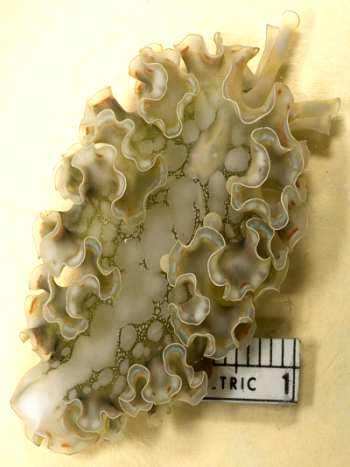
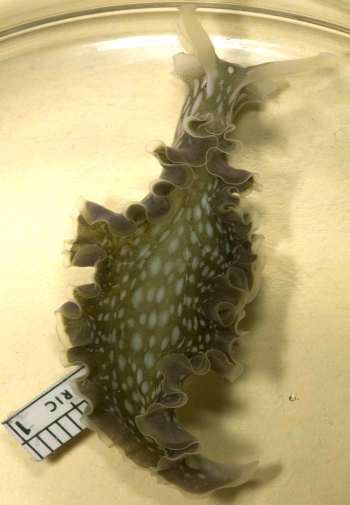
Note added 30 May 2006: This also refers to Elysia clarki, a new species which was previously considered a colour form of E. crispata
Hi Bill-
Glad you're back in cyberspace. Happy New Year. Just to show you we've been working while you were off line, have a look at the attached photo. Same species or not, do you suppose (I've already been in contact with Kathe Jensen)?? Actually, I think we know the answer and are writing a paper, but I thought you might like to see the picture. Once I'm sure of the data (couple more weeks) I'll tell you what the answer turned out to be.
Skip
pierce@cas.usf.edu
Pierce, S. K., 2005 (Jan 4) Elysia crispata - Here's a puzzle. [Message in] Sea Slug Forum. Australian Museum, Sydney. Available from http://www.seaslugforum.net/find/12896Thanks Skip,
Very tantalising message. I look forward to the answer
Best wishes,
Bill Rudman
Update on Elysia crispata feeding
August 6, 2004
From: Skip Pierce
Note added 30 May 2006: This may also refer to Elysia clarki, a new species which was previously considered a colour form of E. crispata
Glad to see the forum back in limited action. Quick note on Elysia crispata feeding. we're about to publish a paper on it, but you can raise the slug from juvenile to adult on Bryopsis for sure, and at least for a while, on Derbesia. The adults (but not the juveniles) also eat Penicillus capitatus and we have found chloroplast gene sequences from that species of alga in field collected slugs, along with Halimeda. Puzzlingly, in spite of the literature, we have found no evidence that they eat any species of Caulerpa - as juveniles or adults - in either feeding experiments or from molecular markers. We still don't know all the details of the life cycle-but I'm starting to think it's quite long for E. crispata - maybe 2 years - but not without food. They can keep the symbiotic plastids going for 3-4 months, but that's it and without the correct food, will die after that.
Skip Pierce
pierce@cas.usf.edu
Pierce, S., 2004 (Aug 6) Update on Elysia crispata feeding. [Message in] Sea Slug Forum. Australian Museum, Sydney. Available from http://www.seaslugforum.net/find/12731Thanks Skip,
Very interesting. I had puzzled over how aquariists had by accident been able to breed E. crispata from eggs to adults in their tanks withour any Halimeda.
Best wishes
Bill Rudman
Re: Elysia crispata feeding
July 16, 2004
From: Pszemol
Note added 30 May 2006: This may refer to Elysia clarki, a new species which was previously considered a colour form of E. crispata
I am a fish tank hobbyist and I have one Elysia crispata in my 30 gallons tank. I would like to confirm it does eat Derbesia (or Bryopsis - I am not sure which one is in my tank).
I saw it the other day near the side glass, at the patch of green hair algae... So I ran for my stamp loupe and started staring at this beautifull creature... Hair algae under 10x magnification looked like long tubes filled with transparent, green liquid... The Lettuce slug's technique of eating algae is very interesting: It aproaches a single hair with its soft mouth and hugs it with its lips. Then you can notice like puncturing the cell wall of the algae and it starts sucking out the green fluid from the algae. When the walls of the algae body collapse, the slug fills it back with water (saliva?) and goes back to sucking... You can clearly see grean parts of algae body intermixed with transparent or whitish saliva (?)flowing in sucking action to the slug mouth. Sucking and refills repeat many times until the algae cell is completely empty and transparent clean.
I also have some Halimeda species and Feather Caulerpa, but I did not observe it while eating these. I am kind of disappointed with what I just read here about their short life span. Is this common to all slugs? What are the signs of the elder stage? I am thinking to purchase more of these snails to help control the outbreak of Derbesia in my tank.
Greetings to all!
Pszemol
Chicago, IL.
pszemol@bigfoot.com
Pszemol, 2004 (Jul 16) Re: Elysia crispata feeding. [Message in] Sea Slug Forum. Australian Museum, Sydney. Available from http://www.seaslugforum.net/find/12583Dear Pszemol,
Your observation of the slugs sucking in the cell contents than regurgitating some of the material back into the plant is an interesting observation. It is called buccal regurgitation and has been reported by Kathe Jensen (1981) for a number of species including Ercolania funerea, Placida kingstoni and Elysia ornata. I don't know what its function is, or if it has been reported for Elysia crispata or other sacoglossans, but its certainly a useful observation.
Don't be too depressed about their relatively short life span. You'll see from other messages that quite a few people have been successful in breeding many replacements. You just need 2 to start with.
• Jensen, K.R. (1981) Observations on feeding methods in some Florida ascoglossans. Journal of Molluscan Studies, 47: 190-199.
Best wishes
Bill Rudman
Re: Elysia feeding
March 1, 2004
From: Skip Pierce
Note added 30 May 2006: This may also refer to Elysia clarki, a new species which was previously considered a colour form of E. crispata
Here's a few more comments with respect to Kathe's reply [#12319]. Elysia crispata is quite interesting in regard to feeding and may be fairly unique among the elysiids because of its lack of food specificity (thanks for that reference by the way). As I said before, we were completely unable to raise the juveniles on any species of Caulerpa, including C. verticellata. The adults did not eat Caulerpa either. I can't explain the different result reported by Kathe. From out experiments, I sort of suspect that the juveniles might eat bacterial or maybe algal films because they survive for a least a couple of weeks without any macroalgae-but will ultimately die unless Bryopsis (or Derbesia) is available. E. crispata will make it to adulthood on Bryopsis alone, my technician has grown some from eggs up to 1.5 inches long (she has much more patience than I) - but we do not yet know anything about chloroplast longevity in that case-and in the field (at least in the Florida Keys) they clearly switch to Penicillus and Halimeda at some point. Our molecular markers found symbiotic plastids from those algae and not from Bryopsis (probably we should look for tiny E. crispata in the field and see whose plastids they have) - or anything else. E. crispata can maintain the plastids for about 3 months, so presumably in the animals we field collected, the Bryopsis plastids taken up (if in fact they do) as juveniles have worn out and been replaced by the Penicillus and Halimeda organelles. But, without one of those species of algae around, E. crispata will eventually turn brown and die. All of this caught us sort of by surprise, because of the years I've spent working on E. chlorotica. That species has an extensive planktonic period (3 weeks-compared to E. crispata where the veliger stage is mostly passed before hatching - maybe 24 hrs post hatch to metamophosis) and, at least in the lab, absolutely will not metamorphose without Vaucheria (again unlike E. crispata which happily metamorphoses without any algae present). E. chlorotica keeps it's plastids throughout the entire life cycle (9 months or so) - and as far as we know - has a complete specificity for Vaucheria. We do not know how long E. crispata lives (maybe someone knows??), but I'd bet 2 years as long as there is the correct algae around - if the correct algae is not around, E. crispata will die, but E chlorotica will live to the usual end of it's life cycle without algae (after an initial feeding), because it takes better care of its plastids. So that's our story -papers will be out soon - it demonstrates, among other things the difficulties of working on natural populations of species with interesting biology (the chloroplast symbiosis, in this case), but with little information available about the natural history.
Skip Pierce
pierce@cas.usf.edu
Pierce, S.K., 2004 (Mar 1) Re: Elysia feeding. [Message in] Sea Slug Forum. Australian Museum, Sydney. Available from http://www.seaslugforum.net/find/12332Re: Elysia feeding
February 27, 2004
From: Kathe R. Jensen
Note added 30 May 2006: This may also refer to Elysia clarki, a new species which was previously considered a colour form of E. crispata
Dear Skip & Bill,
I was very excited to read Skip's message. [#12310]:
When I worked in Florida we raised E. crispata on Caulerpa verticillata, which also has very fine filaments. That was the only alga they would eat (I cannot remember if we tried Bryopsis - we never had a lot of it, and when we did, we usually also had a sacoglossan that needed it). We did not see the adults feed, but we detected growth on several algae - but I would have to find my old notebooks to see which algae we actually tried. I think Halimeda spp. were included.
Maybe this is the right place to mention that as far as I know, Derbesia and Bryopsis are very closely related, but in Bryopsis the macrothallus is the gametophyte and in Derbesia the macrothallus is the sporophyte.
It would be interesting to see whether the diet of the juveniles influences the diet of the adults, i.e. if juveniles are fed only Bryopsis, will they be more diet specific as adults than if they have been feeding on different things as juveniles.
I look forwards to seeing the publications.
Cheers,
Kathe
krjensen@zmuc.ku.dk
Jensen, K.R., 2004 (Feb 27) Re: Elysia feeding. [Message in] Sea Slug Forum. Australian Museum, Sydney. Available from http://www.seaslugforum.net/find/12319Elysia feeding
February 26, 2004
From: Skip Pierce
Note added 30 May 2006: This may also refer to Elysia clarki, a new species which was previously considered a colour form of E. crispata
Hi Bill,
I¹ve been reading the recent batch of messages on Bahamian elysiids with interest. In particular, the comments about what algae they might be feeding on. We have been working with Elysia crispata lately, as that is the species in which we¹ve been able to demonstrate the presence of an algal nuclear gene in the slug genomic DNA. [message #9830]. For us the issue became whose (what species of algae) gene is it? The literature is confusing with respect to the algae that E. crispata consumes. For many months we were doing a variety of molecular and biochemical experiments with the wrong, as it turned out, information that E. crispata was a Caulerpa eater. In fact, it does not eat Caulerpa at all. To make a long story short, my graduate student, Nick Curtis, and post doc, Steve Massey, have spent the last year showing, with both molecular markers and electron microscopy, that the sequestered chloroplasts in E. crispata actually originated in THREE species of algae, (Penicillus capitatus and two species of Halimeda). Furthermore, if you take starved, non-green E. crispata (they turn a brownish-yellow after their symbiotic plastids fail) and put them on Caulerpa, they die, but if you put them on P. capitatus they rapidly recover both their green color and their intracellular chloroplasts. This is the first time that I know of where chloroplasts from more than one species of algae has been found in an elysiid - in fact some of our micrographs show plastids from two algal species in the SAME cell in E. crispata. Even more remarkable (at least to me - remember that I¹m basically a cell biologist, so I¹m easily amazed) is that E. crispata juveniles do not eat P. capitatus (or Caulerpa). We raised a bunch of juvenile E. crispata from egg masses and put them on a wide array of chlorophyte species (including several Caulerpa spp). They only ate Bryopsis and, to my surprise (because it does not occur with much abundance in the field sites in the Keys where we collect the adult slugs), Derbesia. We have not yet finished the microscopy to see if the juveniles sequestered the plastids from both these species, but the juveniles survived, grew, and took on adult morphology in both cases. Having worked for many years on E. chlorotica,, which is extremely specific about what it eats, namely Vaucheria (although it will eat V. litorea or V. compacta) or nothing, this wider algal preference in E. crispata was a surprise (not to mention a complication in the sense of our molecular experiments).
I sort of think that the differences between the juvenile and adult preferences in algae may be related to algal filament size. Both Bryopsis and Derbesia have very narrow filaments, which may be easier for the juvenile mouths and radulae to handle, compared to the wider (and more calcified) P. capitatus. Furthermore, the filaments of P. capitatus are narrower than those of P. dumentosus (your posting a picture of that alga is actually what set me off on this message) and E. crispata will not eat the latter species either, perhaps because the filaments are too wide. Anyway, all this will be published shortly in a couple of papers and I¹m sorry for going on and on - but these experiments have made me cautious about what¹s in the literature about algal food of elysiids as this is second time we¹ve been led down a wrong path (the other was that E. chlorotica was supposed to eat Codium, which it does not). Finally, I¹d like to know if Ms. Poddubetskaia found any E. crispata on her trip to the Bahamas. I¹ve been in touch with some of the people at the Stocking Island lab, but they did not know of any there.
Hope all is well.
Skip
----------------
Sidney K. Pierce
Professor and Chair
Department of Biology
University of South Florida
Tampa, FL 33620
www.cas.usf.edu/biology/pierce.html
pierce@cas.usf.edu
Pierce, S.K., 2004 (Feb 26) Elysia feeding. [Message in] Sea Slug Forum. Australian Museum, Sydney. Available from http://www.seaslugforum.net/find/12310Dear Skip,
Thanks for this timely warning. Concerning sacoglossans changing food, have a look at Brian Brandley's paper on an Elysia in Sydney which changed food three times and was able to keep the plastids from all 3 plants alive and functioning. Unfortunately the reality of finding a 'real' job meant he was never able to follow up this promising research
I am interested to hear of the puzzle of the food of juvenile Elysia crispata. You may have seen a number of aquarium keepers have by luck ended up with thriving populations of baby animals. I have wondered what they were feeding on. Could it be juvenile Bryopsis?
• Brandley, B., 1984. Aspects of the ecology and physiology of Elysia cf. furvacauda (Mollusca: Sacoglossa). Bulletin of Marine Science, 34: 201-219.
Best wishes
Bill Rudman
Elysia crispata - breeding in aquarium
January 9, 2004
From: Paul Baldassano
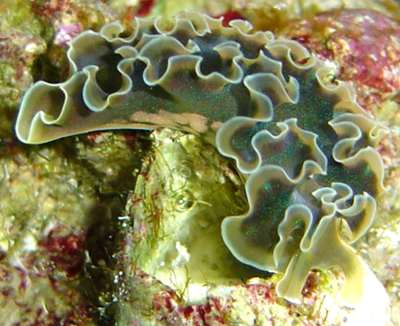
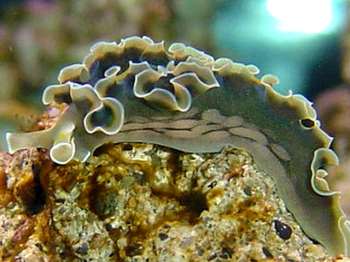
About seven weeks ago I aquired an Elysia crispata to put in my thirty two year old 100 gallon reef tank. Now I have over 100 of them. I can not find the original "mother" but the rest of them continue to reproduce and grow to adulthood. I know they are still reproducing by the numerous babies populating every inch of the tank. I have never observed them eating anything and they seem to prefer bare rocks to algae covered rocks. I have been selling them to aquarium stores. I am curious to see if the population continues to increase.
I have been a diver since 1971 and I believe I have one of the oldest reef tanks in existence. I attribute this to the fact that I use some natural water, plankton, and amphipods that I collect locally in New York.
Paul Baldassano
Urchsearch@AOL.com
Baldassano, P., 2004 (Jan 9) Elysia crispata - breeding in aquarium. [Message in] Sea Slug Forum. Australian Museum, Sydney. Available from http://www.seaslugforum.net/find/11846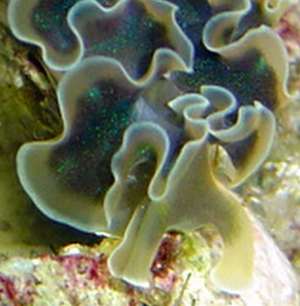
Thanks Paul,
Elysia crispata seems to be an excellent aquarium 'slug'. As you have discovered it can happily reproduce in aquaria and apparently feeds on microscopic green algae which have no trouble growing in aquaria. As you may have read on the Forum, Elysia crispata is one of those Solar-powered sea slugs which keep chloroplasts from the algae alive in their own tissues where they photosynthesise and provide sugars and other nutrients for the slug. This will only work in aquaria if you have the appropriate lights. In the close-up photo alongside, the dark green regions are where the algal material is kept alive in the slug.
Concerning the breeding. I suspect the one animal you bought had already mated and so was able to lay many fertilised eggs in your aquarium over a period of time. These have gradually hatched and begun to grow providiing you with the apparently 'inexhaustible' supply of new ones. I am not sure how long they take to reach maturity but once the first ones do, hopefully you will have a second generation, and then a third, etc, etc.
Best wishes
Bill Rudman
Elysia crispata from Jamaica
October 10, 2003
From: Ross W. Gundersen
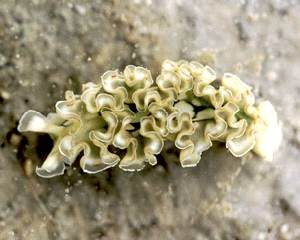
Dear Bill:
Here is another sea slug from Jamaica. As I said in my first message, all specimens were collected from St. Ann's Bay, Jamaica, West Indies. Photo: R. Gundersen.
Here is Elysia crispata. Found in crevices in the back reef . Colours are extremely variable ranging from light tan to blue to purple.
Best wishes,
Ross
ross.gundersen@uwp.edu

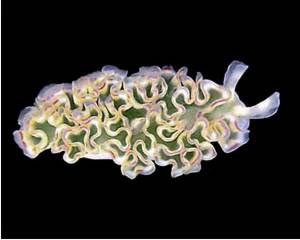
Thanks Ross,
Bill Rudman
Elysia crispata from Colombia
October 1, 2003
From: Ana Karina Yepes
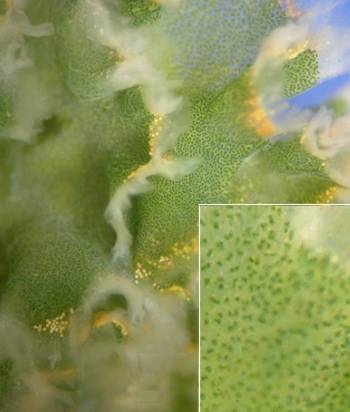
Hello,
I have been working a little with Elysia crispata and I would like to know if there is an specific methodology to extract the symbionts they contain. We are trying to examine the stomach to find little pieces of algae, or perhaps the zooxanthellae, but in two occasions we have failed and found nothing, and the content doesn´t even take the lugol, to find polysaccharids.
I add a photograph of the slug collected in Isla Fuerte, Colombia. It is a detail of the parapodia… from which I have one question. Is this coloration due to the pigments they extract from the algae? If this one has an orange color, one could expect to find carothenes in it? And, where is the tissue that contains the chloroplasts?
Thanks
Ana Karina Yepes Gómez
Lab. de Productos Naturales bioactivos marinos
Instituto de Biologia
Universidad de Antioquia
Medellin, Colombia
akyg01@matematicas.udea.edu.co
Yepes, A. K., 2003 (Oct 1) Elysia crispata from Colombia. [Message in] Sea Slug Forum. Australian Museum, Sydney. Available from http://www.seaslugforum.net/find/11030Dear Ana Karina,
Firstly Elysia contains chloroplasts not zooxanthellae. The green specks in your photo are indeed clumps of living chloroplasts and so they retain their green pigments. The yellow and other colours in these animals seem to be unrelated to photosynthesis and are produced by the animal. If you look through the other messages and the Fact Sheet you will find addresses of people who are currently working on the chloroplast symbiosis and are probably the best people to contact for advice. You will also find quite a few references on the Forum on this topic
Best wishes
Bill Rudman
Elysia crispata from Bonaire
September 11, 2003
From: Robert Fishman
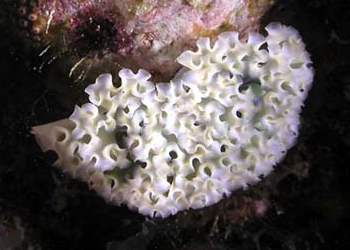
Bill,
During a recent visit to Bonaire [Netherlands Antilles] in February 2003, I came across this example I believe to be Elysia crispata. Would you be able to verify?
Thank you,
Bob
bob@rfp.com
Fishman, R., 2003 (Sep 11) Elysia crispata from Bonaire. [Message in] Sea Slug Forum. Australian Museum, Sydney. Available from http://www.seaslugforum.net/find/10937Dear Bob,
Yes this is Elysia crispata.
Best wishes
Bill Rudman
Light color form of Elysia crispata
July 21, 2003
From: Linda Ianniello
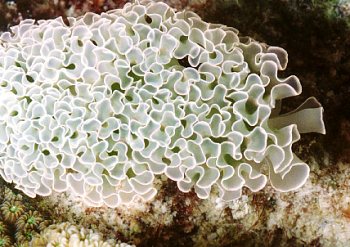
Dr. Bill,
Here is another color form of Elysia crispata. I recently spent 5 days diving in Bonaire, Netherlands Antilles, and there were a lot of Elysia crispata in both the green and blue forms already documented on the Forum. But there were also several that looked pale greenish-grey with a striking white border. Here is a picture of one. Most of the slugs were a good size - between 2 and 3 inches, and generally were found about 20 to 30 feet deep, below the surge zone. Surprisingly, for the number of slugs I saw, I never saw an egg string. Nor did I find any other sea slugs there during day or night dives.
Location: Bonaire
Depth: 30'
Date: June, 2003
Regards,
Linda I.
lindai@us.ibm.com
Ianniello, I., 2003 (Jul 21) Light color form of Elysia crispata. [Message in] Sea Slug Forum. Australian Museum, Sydney. Available from http://www.seaslugforum.net/find/10414Thanks Linda,
Bill Rudman
Chloroplasts in Elysia crispata
June 30, 2003
From: Skip Pierce
Hi Bill
I can't confirm that the suspected Elysia diomedea in the recent posting is such, but it is not Elysia crispata. Not a very useful comment, I guess. However, the message gave me pause to review your message archive on E. diomedea, which includes some anatomical comparisons to E. crispata. We have found (looking with electron microscopy), in contrast to the Marcus paper you cite that says the symbiotic plastids in E. crispata are located in the connective tissue, that the symbiotic chloroplasts are in fact in the cells lining the digestive tubules-right where they ought to be. I don't know why Marcus thought otherwise. C. M. Yonge, in an ancient paper on "Tridachia" crispata (actually one of the first papers recognizing the symbiosis in elysiids, I think), mistook the plastids for zooxanthellae (but he was doing the work on the Dry Tortugas in the 1940's, so it's unlikely that he had an EM), which, if present, might be located in the blood sinuses - thus apearing to be in the connective tissue perhaps - but so far we have not seen any evidence (EM or molecular) for zooxanthellae in E. crispata - so with due respect to the Marcus paper, chloroplast location should not be used as a defining anatomical characteristic for these two species.
Hope all is well.
Skip
pierce@chuma1.cas.usf.edu
Pierce, S., 2003 (Jun 30) Chloroplasts in Elysia crispata. [Message in] Sea Slug Forum. Australian Museum, Sydney. Available from http://www.seaslugforum.net/find/10331Thanks Skip,
From my experience, unless specimens are properly fixed for histological examination, it is very easy to misinterpret anatomical detail. Properly 'fixing' specimens is quite difficult with opisthobranchs because if you try and 'relax' them before preservation, so they don't retract into a tiny ball, you run the risk of tissue breakdown occurring before the muscles stop working. Sometimes the skin layers can be rotting away while the foot is still capable of contraction. The tissues of the digestive system are one of the first to start disintegrating. Flatworms also cause similar difficulties. It is one of the reasons that some textbooks recommend flooding flatworms with a boiling Bouins solution [a nasty mixture including picric acid and formalin]. It certainly kills them so fast that they don't have time to contract. I have found that cold Bouins [I've never had the courage to boil it] works well on some opisthobranchs - Tergipedidae, Dermatobranchus, Elysia - but fails for many.
Cheers,
Bill Rudman
More on Elysia crispata - feeding, DNA etc
May 8, 2003
From: Skip Pierce
Note added 30 May 2006: This may also refer to Elysia clarki, a new species which was previously considered a colour form of E. crispata
Hi again Bill,
I want to be cautious on the following because we have not been working with E. crispata very long, but in answer to Kathe's question - we have not found fucoxanthin in E. crispata (haven't looked for it, actually). We have found a gene in the slug DNA for one of the proteins in the chloroplast light harvesting system that is called fucoxanthin-chlorophyll binding protein. Without boring all your readers to tears, the presence of the protein does not necessarily mean that the pigment fucoxanthin is present-possibly it's just a type of chlorophyll binding protein that binds different pigments in different species-and I don't think E. crispata eats brown algae, but might eat diatoms from surface films. Anyway, for us the issue is where the endosymbiotic plastids come from in E. crispata. We're isolating plastid DNA from endosymbiotic plastids isolated from adult slugs and doing PCR. We're also doing juvenile feeding experiments. We aren't done yet, but unlike E. chlorotica which is every specific in it's algal food requirements, E. crispata may turn out to either eat a lot of different stuff (which will make our cell biological studies a nightmare ie - might be more than one species' plastids) or else switch algal species as it grows - just do not know yet, but we may fairly soon - or not as these experiments sometimes go.
Skip
pierce@chuma1.cas.usf.edu
Pierce, S.K., 2003 (May 8) More on Elysia crispata - feeding, DNA etc. [Message in] Sea Slug Forum. Australian Museum, Sydney. Available from http://www.seaslugforum.net/find/9879Thanks Skip,
Don't worry about 'boring all your readers to tears'. The number of daily visits to the Forum continues to rise - last month there were over 1600 per day. I guess they aren't all interested in fucoxanthins, but those that are will be grateful for your progress reports.
Cheers
Bill Rudman
Re: Elysia crispata and algal genes
May 5, 2003
From: Kathe R. Jensen
Note added 30 May 2006: This may also refer to Elysia clarki, a new species which was previously considered a colour form of E. crispata
Dear Bill & Skip,
I am sitting in the middle of my moving mess (this time I only moved about 100m to a larger apartment - where supposedly I will not have to keep books in boxes on the floor, though that is exactly what I do have all around me), and then this interesting conversation pops up. I will be very interested in hearing Skip's results about the feeding of Elysia crispata. I have actually observed the juveniles (hatched from egg masses in the lab) feed on Caulerpa verticillata, so I know that they can feed on this alga and grow. I have never seen an adult E. crispata feed on anything, and in most cases they didn't grow in our tanks - they were just there for months, spawning and looking healthy - and maybe feeding after the lights were off at night.
I would like to know if the presence of fucoxanthin implies that it feeds on brown algae, because this has been implied for the very similar E. (Tridachiella) diomedea [= Tridachiella diomedea], but never confirmed.
Greetings,
Kathe
krjensen@zmuc.ku.dk
Jensen, K.R., 2003 (May 5) Re: Elysia crispata and algal genes. [Message in] Sea Slug Forum. Australian Museum, Sydney. Available from http://www.seaslugforum.net/find/9857Thanks Kathe,
I'm glad to see you haven't let a domestic crisis interfere with a good slug story
Bill Rudman
Elysia crispata research
March 11, 2003
From: Dirk Trauner
Dear Dr. Rudman:
I am a natural products chemist at UC Berkeley. We are very interested in bioactive compounds isolated from sacoglossan molluscs. Recently, we published a total synthesis of photodeoxytridachione, a compound found in Tridachia crispata and Plakobranchus ocellatus.
As an inspiration, I'd like to keep some of these fascinating slugs in a tank in my office. Is this possible? What skills does it take to keep them happy ? Where can you get the animals from?
• Miller, A. K.; Trauner, D. Angew. (2003) Total Synthesis of (+)-Photodeoxytridachione Using a Novel Lewis Acid Catalyzed Cyclization. Angewandte Chemie Int. Ed., 42: 549-552.
Best,
Dirk
Department of Chemistry
University of California, Berkeley
http://www.cchem.berkeley.edu/~trngrp/traunerweb/
trauner@cchem.berkeley.edu
Trauner, D. , 2003 (Mar 11) Elysia crispata research. [Message in] Sea Slug Forum. Australian Museum, Sydney. Available from http://www.seaslugforum.net/find/9342Dear Dirk,
Just to clarify names, we now consider Tridachia crispata to be in the genus Elysia, so its current name is Elysia crispata. Sorry our names are not as constant and unchanging as the Periodic Table, but scientific names also reflect an animal's evolutionary relationships, so when we have new insights on relationships, names sometimes have to change. Concerning the whereabouts of live specimens - California is a hotbed of opisthobranch fanatics so if you're lucky one may get in touch with you. It may be possible to get some specimens of Elysia diomedea, which is the east Pacific 'cousin' of the Caribbean Elysia crispata. Failing that, have a look at my reply to an identical earlier inquiry. If you scroll down the page below your message you will see the earlier messages about this animal. You will see there that they are not that difficult to keep and breed in aquaria.
Good Luck,
Bill Rudman
Elysia crispata toxicity..
September 17, 2002
From: Ken Woden
Hi.
After several months of waiting for some kind of relief from a Bryopsis outbreak, I broke down and bought a Lettuce Sea Slug. I am a little bit confused about their toxicity, though. I know their nudibranch cousins are toxic, but is this little guy toxic? Hopefully I'll never have to deal with him getting sucked into a filter intake or the like (I've screened EVERYTHING off), but just in case something happens, I'd like to know whether to freak out or not. Also, do sea slugs sleep? I've noticed mine goes through stages of activity and "laziness." I had one a few months ago that did the same thing (I sold it to a fellow hobbyist who had much more hair algae). Is this normal behaviour?
Thanks!!
savemyday087@yahoo.com
Woden, K., 2002 (Sep 17) Elysia crispata toxicity... [Message in] Sea Slug Forum. Australian Museum, Sydney. Available from http://www.seaslugforum.net/find/7973Dear Ken,
Many sacoglossans such as Elysia apparently store distasteful chemicals from their algal food to use in their own defence. However I suspect they deter rather than kill potential predators. If you look at other messages on this page there are no warnings that they wreak havoc in aquaria. Concerning slugs sleeping - quite a few seem to have a diurnal [day/night] activity cycle - but I don't know if the inactive period counts as 'sleeping'.
Cheers,
Bill Rudman
Re: Elysia crispata question...
December 18, 2001
From: Matt Galvin
Concerning the question about how much damage Elysia crispata can survive, my E. crispata suffered a minor accident about a month ago as well. While rearranging my rock, it got caught in between two pieces. It sheared the frills on almost the entire right side of its body. Happily, almost a month later, the frills are entirely grown back.
More importantly, I would rig up a grill or screen to prevent it from happening again.
Matt
luminary@liquidchaos.net
Galvin, M., 2001 (Dec 18) Re: Elysia crispata question.... [Message in] Sea Slug Forum. Australian Museum, Sydney. Available from http://www.seaslugforum.net/find/5849Thanks Matt,
Bill Rudman
Elysia crispata question...
December 12, 2001
From: Rich Hunziker
I recently had an accident with my Elysia crispata mine and I needed some urgent info ....
It decided to explore my protein skimmer overflow box and crawled in through the inlet box. Well, needless to say when I got home that night the skimmer was making an awful noise. What had happened is the slug was sucked into the Rio pump and had actually jammed the blades of the motor. I immediately powered it off and within a few seconds my little buddy was crawling out onto my hand. I placed her in a safe part of the tank to determine the damage. A few days have gone by now and she appears to be somewhat ok. (As much as can be expected) She is missing half of her frilly section of her body, half of an antennae, and a smaller section out of what I would call her lip/mouth area. She is still active which is encouraging, but I am concerned about any
pain or suffering.
Will she recover?
Thanks,
Rich Hunziker
Rich.Hunziker@apropos.com
Hunziker, R. , 2001 (Dec 12) Elysia crispata question.... [Message in] Sea Slug Forum. Australian Museum, Sydney. Available from http://www.seaslugforum.net/find/5825Dear Rich,
To stop confusion I changed the name in your message from Tridachia crispata which is a name no longer in use.
We don't know an awful lot about regeneration in opisthobranchs other than that they seem to be able to regrow quite significant amounts of their body. I suspect your skimmer saboteur will make a complete recovery. I'm afraid I can give you no indication on pain and suffering. Clearly all animals respond to stimuli, and damage no doubt is a major source of stimuli - but whether their little 'brains' feel pain & suffering as we understand it I have no idea. Considering what it has survived, however, I reckon it deserves a chance to recover.
Best wishes,
Bill Rudman.
Re: Advice of keeping Elysia crispata in captivity
October 9, 2001
From: Kathe R. Jensen
Note added 30 May 2006: This may also refer to Elysia clarki, a new species which was previously considered a colour form of E. crispata
Dear Claude,
Sorry I didn't reply to your message before. It arrived just before I left for a fieldtrip, and then I guess I just forgot until now there was another message on Elysia crispata. As I said, it has been almost 20 years since I worked in Florida, but at that time we collected Caulerpa verticillata from tidal canals on Key Largo. One of the best places was near Lake Surprise. You can find more information about sacoglossan habitats in the paper by Clark & DeFreese (1987).
It has been shown previously (Clark & Busacca, 1978) that adult Tridachia (which they were called then) will eat Bryopsis, but it is a little difficult for me to imagine how they can eat cyanobacteria. They feed suctorially, and as far as I know, cyanobacteria do not have liquid "cytoplasm" (they are not eucaryotic cells, so I don't think we should actually call it cytoplasm). The texture of the "cytoplasm" is like a rather stiff jelly, so it would be almost impossible to suck out. However, I cannot explain the change of colour you describe. This is something that need to be studied in more detail, e.g. by electron-microscopy and extraction of pigments.
References:
• Clark, K.B. & Busacca, M. 1978. Feeding specificity and chloroplast retention in four tropical Ascoglossa, with a discussion of the extent of chloroplast symbiosis and the evolution of the order. Journal of Molluscan Studies, 44: 272-282.
• Clark, K.B. & DeFreese, D. 1987. Population ecology of Caribbean Ascoglossa (Mollusca: Opisthobranchia): A study of specialized algal herbivores. American Malacological Bulletin, 5: 259-280.
Greetings,
Kathe
jensen@ait.ac.th
Jensen, K.R., 2001 (Oct 9) Re: Advice of keeping Elysia crispata in captivity. [Message in] Sea Slug Forum. Australian Museum, Sydney. Available from http://www.seaslugforum.net/find/5423Re: Elysia crispata
October 9, 2001
From: Anne DuPont
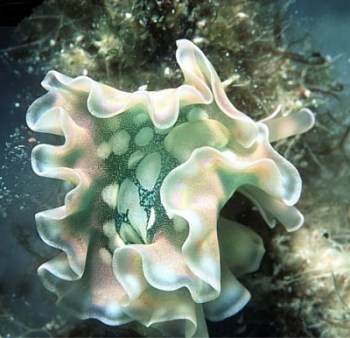
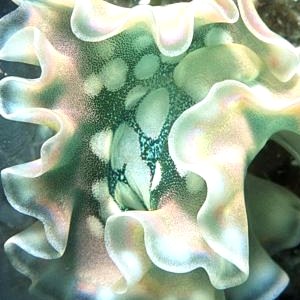
Hello Bill,
I saw your Oct 8 posting regarding the chloroplasts in the "lettuce leaf nudibranch"
Here is a photo I took of Elysia crispata in July 2001 in Little Cayman (Cayman Islands, British West Indies) in about 45 feet of water.
Best Regards,
Anne
akdupont@bellsouth.net
DuPont, A., 2001 (Oct 9) Re: Elysia crispata. [Message in] Sea Slug Forum. Australian Museum, Sydney. Available from http://www.seaslugforum.net/find/5425Thanks Anne,
I have included an enlarged view to show the green clumps of chloroplasts more clearly.
Best wishes,
Bill Rudman
Chloroplasts in the 'lettuce leaf nudibranch'
October 8, 2001
From: Caroline Nelson
Hello,
I am a Junior at Salem College in North Carolina, USA. I am doing a proposal, and hopefully research, on the chloroplasts in the Tridachia crispata which can be found specifically on the west coast of Barbados. I have done research in Barbados before and the team I was with found that some of the inhabitants of the reef had changed their diet (still being researched). Everywhere there was a Lettuce Sea Slug it was not found near it's food sources. My question is how long can the sea slug go without eating its base diet, and surviving off of the nutrients provided by the chloroplasts that are still functional? How long do the cholorplasts survive in the sea slug? What exactly are they providing the sea slug? Is there an easy way to test the sea slug to prove that it is in fact using the chloroplasts? ... I have several answers to these questions at the moment but wanted your opinion as well.
Thank you,
Caroline.
nelsoc3@salem.edu
Nelson, C., 2001 (Oct 8) Chloroplasts in the 'lettuce leaf nudibranch' . [Message in] Sea Slug Forum. Australian Museum, Sydney. Available from http://www.seaslugforum.net/find/5398Dear Caroline,
If you are planning to do some research I guess the first step is to have a look at some of the published research on the topic. But firstly, a few words about its name. You will find it called Tridachia crispata but it at present that genus is considered to be an unnnecessary subdivision of the genus Elysia. There are various common names, such as 'Lettuce Sea Slug' but they are confusing. Why not use the scientifc name? Also you call it the 'Lettuce Leaf Nudibranch' which is a new version of the common name. Although a sea slug (Opisthobranch) it is not a nudibranch but a member of another opisthobranch suborder - the Sacoglossa.
Now to the topic of chloroplast symbiosis. If you look at the top of the Elysia crispata Page you will find a few basic references. Have a look at the Solar-powered Sea Slugs Page for some general information on the topic and also the Page dealing specifically with chloroplast references. Many of the topics you raise have already been discussed on this page so have a look at the other messages about Elysia crispata, in particular my comments on Alan Pittman"s message. There are also many relevant messages on the Elysia chlorotica Page.
Good luck in your studies,
Bill Rudman
Re: Advice of keeping Elysia in captivity
September 24, 2001
From: Claude Poole
Note added 30 May 2006: This may also refer to Elysia clarki, a new species which was previously considered a colour form of E. crispata
Hello Kathe,
Sorry for butting in. I have a couple of adult Elysia crispata who presented me with several babies some weeks back. I had purchased the adults to help with an outbreak of Bryopsis. Unfortunately I would have needed an army to rid the tank of the plague. It disappeared as suddenly as it appeared, perhaps because I hiked my alkalinity. For some weeks the slugs seemed to be finding enough left over on the rocks. Then they munched on the cyanobacteria which followed the death of massive amounts of Bryopsis. I know they were feeding on the cyano because their color changed to include some purple. They are obviously starving slowly and I feel very badly.
I tried, unsuccessfully, for weeks to find the Caulerpa verticillata which you mention. If you have a source, I would be very grateful if you let me know. I live in the US. I had purchased the slugs from Pete at Reeftopia.com. Pete is a diver off the coast of Florida. They were beautiful and I would like to keep them as an addition to my reeftank. One of the adults grew to 4" in length when extended. The babies are now about 1".
Thanks,
Claude
poolzoo1@cs.com
Poole, C., 2001 (Sep 24) Re: Advice of keeping Elysia in captivity. [Message in] Sea Slug Forum. Australian Museum, Sydney. Available from http://www.seaslugforum.net/find/5328Dear Claude,
Don't apologise for butting in - that's what you are supposed to do. I hope you have some success at keeping them alive. Have a look doen this page at other messages on this animal. You will see that it does eat other green algae. I suspect if you have a light that assists plant growth you shouldn't have too much problem growing an algal film and filamentous green algae - though I guess you will have to stop 'hiking up the alkalinity'.
Cheers,
Bill Rudman
I need some Bryopsis
September 21, 2001
From: Kathleen Archer
Thanks for the help with Elysia culture. I'm interested in culturing Bryopsis algae in an aquarium, and I see from past messages posted here that Bryopsis is frequently an unwanted guest in marine aquariums. I can't find a dealer who sells it, so I'm hoping I might be able to obtain it from someone who has it but doesn't want it. If you contact me by email, we can work out how to ship it - I'm happy to pay the shipping costs.
Thanks for any help you can give.
Kathleen Archer
Kathleen.Archer@trincoll.edu
Archer, K., 2001 (Sep 21) I need some Bryopsis. [Message in] Sea Slug Forum. Australian Museum, Sydney. Available from http://www.seaslugforum.net/find/5316Re: Advice of keeping Elysia in captivity
September 17, 2001
From: Kathe R. Jensen
Note added 30 May 2006: This may also refer to Elysia clarki, a new species which was previously considered a colour form of E. crispata
Dear Kathleen and Bill,
When I was working in Florida in Kerry Clark's lab. many years ago, we regularly kept what was then Tridachia crispata in our aquaria. They were regular 10 gallon sub-gravel filtered and aerated aquaria with a number of green algae, usually a couple of species of Caulerpa, but sometimes others as well. Illumination was from "Gro-lux"-lights. The animals were collected in the Florida Keys. I think the major problem is that they produce toxic chemicals in the mucus (which is continually secreted from the body surface), so you cannot keep too many adult specimens in the same tank. Juveniles look like typical Elysia [see Jeff Zimmerman's photos] and feed on Caulerpa verticillata. So if you can get one or two specimens which will produce eggs, and you can also supply some Caulerpa verticillata (or possibly other Caulerpa with very thin filaments), you should be able to maintain your own supply. They have lecithotrophic development, meaning that the veligers do not swim very much, and they do not need to feed before settling.
Good luck with your project - and please keep us informed about your results.
Greetings,
Kathe
jensen@ait.ac.th
Jensen, K.R., 2001 (Sep 17) Re: Advice of keeping Elysia in captivity. [Message in] Sea Slug Forum. Australian Museum, Sydney. Available from http://www.seaslugforum.net/find/5275Thanks Kathe,
Bill Rudman.
Advice of keeping Elysia in captivity
September 15, 2001
From: Kathleen Archer
Note added 30 May 2006: This may also refer to Elysia clarki, a new species which was previously considered a colour form of E. crispata
I am just beginning a research project on sacoglossans which retain chloroplasts. Dr. Mary Rumpho, who works with Elysia chlorotica, has generously agreed to collaborate. I would like to look at Elysia chlorotica which will be available for collection from the wild in these parts in late October, but I understand that several tropical aquarium supply houses have a related species, Elysia crispata (formerly Tridachia crispata) available for purchase. I'm interested in working with this species as well.
I am a plant biologist by training, and my interest is in the chloroplasts, and how the slug cooperates with the chloroplasts to give them the environment they need to stay functional and healthy. To start some experiments, I will need to keep E. crispata alive for as along as I can, and so I am interested in information on the conditions, setup, etc. that works the best for this animal. I'm also interested in finding books and articles on how to maintain E. crispata in captivity.
Any first hand information, or suggestion of useful books or articles would be most appreciated.
Thanks very much for your time,
Kathleen Archer
Dept. Biology
Trinity College
Hartford, CT 06106
USA.
Kathleen.Archer@trincoll.edu
Archer, K., 2001 (Sep 15) Advice of keeping Elysia in captivity. [Message in] Sea Slug Forum. Australian Museum, Sydney. Available from http://www.seaslugforum.net/find/5268Dear Kathleen,
Good Luck with your research project. from the messages on the Elysia crispata page it seems they are nnot that difficult to keep and breed in aquaria. Perhaps contact some of the people who have had success in keeping them. As far as a commercial source of supply I suggest you do a web search as commercial suppliers seem to come and go. I did a quick search with www.google.com and found a couple. Ignore their information on feeding etc - I am amazed at what rubbish is being posted on most of these sites. You will need to search on 'Lettuce Slug' 'Tridachia crispata' and 'Elysia crispata' as all three names are used.
Hopefully though, someone reading this will contact you with better information. Please keep in touch with Forum, and let us know what success you have at keeping them alive. It could help some future researcher.
Best wishes,
Bill Rudman
Elysia crispata from Colombia
June 16, 2001
From: Alexander Taborda Marin
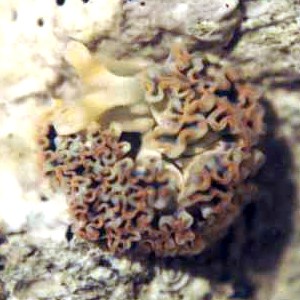
Dear Rudman:
My name is Alexander Taborda Marin, I am student of marine biology from Colombia and actually I have an investigation on nudibranchia in Santa Marta (Colombia- Caribbean sea). Please, I want to know if the organism is Elysia crispata, because the colour is green normally, and this individual have the mantle of colour orange. The length is 30 mm.
Thanks!.
Alexander
alexandertaborda@Hotmail.com
Taborda, A., 2001 (Jun 16) Elysia crispata from Colombia. [Message in] Sea Slug Forum. Australian Museum, Sydney. Available from http://www.seaslugforum.net/find/4580Dear Alexander,
You're definitely luckier than I am, I have never seen this animal alive. If you look at the other messages on this page it is quite variable in colour. Have a look at Anne Dupont's photo from Belize of an animal with very similar orange colouring.
Best wishes,
Bill Rudman
Keeping Elysia crispata in aquaria
February 26, 2001
From: Alan Pittman
Hello there,
My name is Alan, I'm a Biology major in Little Rock, Arkansas. These solar powered slugs are probably one of the most interesting animals I have ever read about. I want to get some Elysia crispata from a marine supplier for my reef tank. The site says they eat hair algae, and after they eat the algae they will not harm other reef inhabitants. I really don't mind if it did munch on some other things, I just want one pretty bad. However after it eats all the hair, then what. Does it then starve to death. Can I feed it seaweed or lettuce. They are selling these things under the name Lettuce Nudibranch, and after much research I can see that it is an Elysia crispata. One final question, just how reliant is this creature on the plastid material it gathers from its food. Will it die without enough sunlight.
Thanks for reading
Alan Pittman
Demogarr@Yahoo.com
Pittman, A., 2001 (Feb 26) Keeping Elysia crispata in aquaria. [Message in] Sea Slug Forum. Australian Museum, Sydney. Available from http://www.seaslugforum.net/find/3863Dear Alan,
I am not an expert at keeping these animals alive in aquaria, but I would hope part of your interest is in succeeding. Clark & Busacca (1978) studied the ability of a number of sacoglossans to retain healthy chloroplasts and found that Elysia crispata was very efficient at doing so, showing that after 58 days of starvation, half the chloroplasts were still alive and functional. They found that after an initial weight loss, the weight of starving E. crispata stabilises after about 28 days, suggesting that at least for a couple of months the slugs can survive on the photosynthetic products of the chloroplasts.
In choice experiments they found that E. crispata would eat a number of species of siphonaceous green algae including Batophora oerstedi, Bryopsis plumosa, Halimeda spp, Penicillus spp, Caulerpa paspaloides and Caulerpa racemosa.
Jensen & Clark (1983) later showed that another species of Caulerpa, C. verticillata (a very finely branched species, which looks a bit like a tiny Christmas tree), is the preferred food of the juveniles of this species.
Have a look at Kathe Jensen's message below. In my comment on Ryan's message I suggested that this species had direct development but Kathe says that it has lecithotrophic development which is where the larvae are free-swimming, but only spend a short non-feeding period in the plankton. Ryan obviousy had success in breeding some E. crispata because he had turned off his filter system and so saved the veligers from being filtered out.
I would suspect that if you have one of the lights which allows algae to grow in aquaria you should have no problem keeping both the algae and Elysia happy. Perhaps you may need to have a second tank for growing algae but I am not sure how necessary that would be. Hopefully someone who has experience at keeping them alive will contact us.
References:
• Clark, K.B.; Busacca, M (1978) Feeding specificity and chloroplast retention in four tropical ascoglossa, with a discussion of the extent of chloroplast symbiosis and the evolution of the order. J. Moll. Stud. 44: 272-282,Figs1-3.
• Jensen, K. & Clark, K.B. 1983. Annotated checklist of Florida ascoglossan Opisthobranchia. The Nautilus 97: 1-13
In the mean time good luck, and keep us informed on how you go,
Bill Rudman
Elysia crispata in aquaria
January 29, 2001
From: Ryan
Hello Folks,
Recently I attempted to create a miniature reef setup in a 10 gallon tank. Much to my dismay, this was an overly agressive project for me and I failed miserably. The only animal I kept with any success was what I belive to be Elysia crispata The one healthy adult I had simply harvested the long hair algae. Unfortunately, when the Elysia crispata dissapeared I thought the only life left was algae and I resorted to removing the light and heat. I also halted general maintenance. Leaving the filter run, I hoped to rid my decor of algae. After about a month, however, my plan changed. Yesterday I noticed 12 juvenile lettuce slugs. I don't want to lose them so I'm hoping someone on this site can give me some advice as I slowly return the heat, light cycle, and salt content. I also notice several very small tube worms and other "bug" like creatres crawling about the live rock. Any light that could be shed upon my situation would be greatly appreciated.
Thanks,
Ryan
ripleyrp@yahoo.com
Ryan, 2001 (Jan 29) Elysia crispata in aquaria. [Message in] Sea Slug Forum. Australian Museum, Sydney. Available from http://www.seaslugforum.net/find/3638Dear Ryan,
You have clearly successfully bred some Elysia crispata. If you look at some of the other messages about this animal you will see that it is a species in which the larval stage is completed in the egg capsule, so that instead of a free-swimming veliger larva hatching from the egg, you have a minute crawling baby slug. They are all obviously very happy with the environment you are providing, as apparently are the other animals which you have noticed.
My advice would be to hasten slowly. Raise the temperature slowly and add other animals slowly. The Elysia are feeding on the 'long hair alga' so it will have to stay if you want to keep the Elysia. If you are lucky the 'babies' will themselves reproduce so you will have a continual supply of Elysia.
Best wishes,
Bill Rudman
What is a Lettuce Nudibranch
October 30, 2000
From: Mike Dean
I have been reading on lettuce Nudi-branch. I cannot find the proper name.. Do you know what it might be. Supposedly they help control Hair Algae.
Mike
sdean2@prodigy.net
Dean, M., 2000 (Oct 30) What is a Lettuce Nudibranch. [Message in] Sea Slug Forum. Australian Museum, Sydney. Available from http://www.seaslugforum.net/find/3261Dear Mike,
I guess the animal you are interested in is Elysia crispata which you'll also find in bools as Tridachia crispata. Have a look at the photos and information above your message. Also have a look at the messages and discussions below your message for some background information. It seems it may be possible to breed these animals in an aquaria, because they have relatively shortlived, non-feeding larvae.
One general point. This animal is not a nudibranch. Sea Slugs or Opisthobranchs are basically snails which have lost their shells, or are in the process of losing them. Bubble Shells (Cephalaspidea), Sea Hares (Anaspidea), sacoglossans (Sacoglossa) and nudibranchs (Nudibranchia), are all different types (Orders) of Sea Slugs. If go to the Species List (click on button in blue bar at the top of the page) and have a look at a few animals from these different Orders you will get an idea of their diversity.
Elysia crispata is a sacoglossan. Sacoglossans are interesting because some of them, like
Best wishes,
Bill Rudman.
Elysia crispata v Tridachia crispata
October 17, 2000
From: Kathe R. Jensen
Dear Bill,
You are asking a tricky question. I think the genus Elysia will probably need to be split into 2, 3 or more genera pending thorough phylogenetic analysis. Kerry Clark had a Ph.D. student who did electrophoresis on a number of Florida Elysia species. Unfortunately this student went away without ever publishing his results. As far as I remember he came up with 3 species groups of which E. crispata was in the middle one, meaning that if we accept Elysia as one genus, E. crispata does not need a separate genus. However, if we decide to split Elysia, then E. crispata and maybe one or two other species need another genus name. This is why I don't want Tridachia to be completely forgotten.
I hope that some day someone will find it sufficiently challenging to do a phylogenetic analysis on the Caribbean plakobranchids, including morphological as well as molecular data. Unfortunately I am a little too far away at the present time.
Best wishes,
Kathe
jensen@ait.ac.th
Jensen, K.R., 2000 (Oct 17) Elysia crispata v Tridachia crispata. [Message in] Sea Slug Forum. Australian Museum, Sydney. Available from http://www.seaslugforum.net/find/3192Thanks Kathe,
I wasn't trying to put you on a spot. I was just curious. Let's hope you can whet some student's appetite to look at the big picture.
Best wishes,
Bill Rudman.
Re: Elysia crispata - egg coil
October 15, 2000
From: Kathe R. Jensen
Dear Bill & John,
Concerning John's message, Elysia crispata [or Tridachia] actually has lecithotrophic development. This means that the larvae are only free-swimming for a short period of time, and do not need to feed in this stage. If you want to get them to metamorphose you should have some of the green alga Caulerpa verticillata (a very finely branched species, which looks a bit like a tiny Christmas tree), which is the preferred food of the juveniles of this species (see Jensen & Clark, 1983).
Reference:
Jensen, K. & Clark, K.B. 1983. Annotated checklist of Florida ascoglossan Opisthobranchia. The Nautilus 97: 1-13.
Greetings,
Kathe
jensen@ait.ac.th
Jensen, K.R., 2000 (Oct 15) Re: Elysia crispata - egg coil. [Message in] Sea Slug Forum. Australian Museum, Sydney. Available from http://www.seaslugforum.net/find/3174Dear John,
This greatly increases your chances of breeding some babies. They will only need to spend a short time as swimming larvae, and during that time they do not feed. However to trigger their change (metamorphosis) from swimming larva to crawling slug, they need to settle on their adult food which is the sea weed Kathe mentions.
Kathe, does your '(or Tridachia)' mean you have doubts about this species being an Elysia or are you just noting the name change?
best wishes,
Bill Rudman.
Elysia crispata - egg coil
October 6, 2000
From: John Batson
Hi there,
I was wondering if anyone had any information on breeding nudibranchs in their aquarium. I have had a couple of Elysia crispata for a few weeks and last night one laid a coil of eggs on the front of my tank. Other than keeping my fish from eating the eggs, is there anything else I can do to help them along
Thanks,
John Batson
Jbatson_78722@yahoo.com
Batson, J., 2000 (Oct 6) Elysia crispata - egg coil. [Message in] Sea Slug Forum. Australian Museum, Sydney. Available from http://www.seaslugforum.net/find/3090Dear John,
I'm pretty sure that the eggs of Elysia crispata develop into free-swimming veliger larvae which spend some time in the plankton, feeding on unicellular plants, before settling down onto their food algae and becoming a crawling slug.
The major problem with keeping larvae in aquaria is that they either get filtered out of the water, get stuck in the surface film, or starve through lack of phytoplankton in the water. Without quite substantial effort, I think your chances of successfully breeding lots of little E. crispata are pretty slight.
Your chances would increase if this was a species which produced non-feeding larvae which only spend a few hours or days in the plankton, but I don't think it is.
Best wishes,
Bill Rudman.
Re: Lettuce Slug
August 3, 2000
From: Jonathan Laxton
Hi there Bill,
Thanks for your assistance. Morgan had already completed his assignment with the scant info he'd somehow collected, but was so excited by what you sent him, that he decided to do it all over again.
Have you had any Marine tank enthusiasts who've been able to keep Nudibranchs alive in captivity? I've tried a few times in my 2.4m tank, but no success. Guess they just starve ?
Kind regards & thanks again.!
Jonathan
Gullivan@Isat.co.za
Laxton, J., 2000 (Aug 3) Re: Lettuce Slug. [Message in] Sea Slug Forum. Australian Museum, Sydney. Available from http://www.seaslugforum.net/find/2824Dear Jonathan,
I'm glad I got the right Lettuce Slug. Concerning keeping nudibranchs alive in aquaria. I have just discussed this with Darla Hatton. If you have a look at the correspondence on the Keeping Slugs in captivity page you will see it's not easy. If you can identify an animal's food and are able to keep a fresh supply of its food available, then you will have no problems, but the food aspect is easy to write in a sentence, but very difficult to achieve in reality.
Best wishes,
Bill Rudman.
What is a lettuce slug? help please......!
July 28, 2000
From: Jonathan LAxton
Hi.....I'm trying to help my son do a school project on "Lettuce Slugs" which I imagine are Nudibranchs. Don't know the Latin name, though. Can anyone please assist with some info, or an address where I could look.
Many thanks
Jonathan Laxton
Gullivan@Isat.co.za
Laxton, J., 2000 (Jul 28) What is a lettuce slug? help please......! . [Message in] Sea Slug Forum. Australian Museum, Sydney. Available from http://www.seaslugforum.net/find/2782Dear Jonathan,
"Common" names like "Lettuce Slug" are a real problem for communication. To me a Lettuce slug would be one of those little nuisances in my garden that eat the lettuces.
If you are sure that the slug your son is interested in lives in the sea, then I am pretty sure that there is a slug from the Caribbean which is called the "Lettuce Slug", not because it eats lettuce, but because it can have a frilly edge to its parapodia, which give it a slight resemblance to a lettuce plant.
The slug is Elysia crispata, and you may find it referred to by an older name Tridachia crispata which we don't use anymore. I am not sure how familiar you are with the web, but if you click on any underlined word or name, you will be taken to a relevant page. Click on Elysia crispata and you will find a page on the 'lettuce slug'. You will also find other messages, with photos and information, below your message, on this page.
Elysia crispata is a sea slug or 'opisthobranch' but it is not a nudibranch. It belongs to the Order Sacoglossa which are herbivorous slugs ranging from primitive species with quite large shells, to ones like Elysia which lack a shell and look quite nudibranch-like. If you click on the SPECIES LIST button at the top of this page and scroll down to the ORDER Sacoglossa, you will find a list of sacoglossan species on the Forum. Have look at some of them to get an idea of their diversity.
I am not sure of your son's interest in these animals but one interesting feature of them is described on the Solar-powered sea slugs page. Elysia crispata is one of a number of species which keeps chloroplasts from the algae it feeds on, alive in its body, where they continue to photosynthesise, providing sugars and other nutrients to the slug. Have a look there for other relevant pages.
I hope this helps you and your son,
Best wishes,
Bill Rudman.
Elysia crispata & photosynthesis
December 10, 1999
From: Dave Behrens
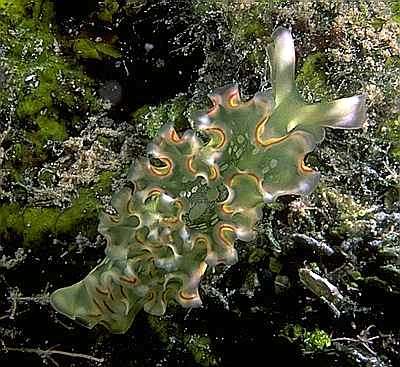
Dear Bill:
I did come across a photo I took this year in Roatan, Honduras of Elysia crispata where the mantle folds are separated sufficiently to expose the oval concentrations of photosynthetic material. Unfortunately the photo did not capture the brilliance of the iridescence I mentioned in my earlier message. A couple of the oval patches at mid-body do give a hint of this, however.
Happy Holidays,
Dave Behrens
Sea Challengers
dave@seachallengers.com
Behrens, D., 1999 (Dec 10) Elysia crispata & photosynthesis. [Message in] Sea Slug Forum. Australian Museum, Sydney. Available from http://www.seaslugforum.net/find/1667Dear Dave,
Thanks for the photo. Is that the usual situation on the inside if the parapodia? Are the chloroplasts only found in a 'ring' around the edge of the white spots or do they fill all the 'interspot space' if present in sufficient numbers?
Bill Rudman.
Rudman, W.B., 1999 (Dec 10). Comment on Elysia crispata & photosynthesis by Dave Behrens. [Message in] Sea Slug Forum. Australian Museum, Sydney. Available from http://www.seaslugforum.net/find/1667Tridachia v Elysia crispata
December 7, 1999
From: David W. Behrens
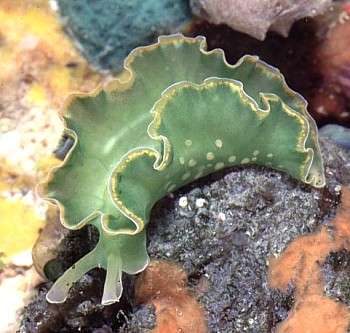
Note added 30 May 2006: This is may be Elysia clarki, a new species which was previously considered a colour form of E. crispata. I cannot tell whether there is a gap between the parapodia in the anterior midline, which is a character of the new speciees - Bill Rudman.
Dear Bill:
May I bring to you and your readers attention the collection of Elysia
crispata photographs on Mike Miller's Site - Nudibranch of the Week #156.
The red lined variation Anne submitted has been the norm for several years in Roatan, Bay Islands, Honduras. Very common. The green mantle aggregations of photosynthetic material in my specimens were absolutely iridescent. They seemed to sparkle and jump right off the tissue at you. I will try to find a photo for you.
Jeff Hamann's mangrove specimen (from Belize), shown here and linked to Mike's page is particularly interesting.
Such an interesting and variable species.
David W. Behrens
dave@seachallengers.com
Behrens, D. W., 1999 (Dec 7) Tridachia v Elysia crispata. [Message in] Sea Slug Forum. Australian Museum, Sydney. Available from http://www.seaslugforum.net/find/1656Dear Dave (& Jeff),
Thanks for the mangrove variety photo. This species does show amazing variety in colour. On reflection I guess I should have placed this species in Elysia rather than persevering with Tridachia. I have changed the species information at the Top of the Page, to follow Gosliner's review (1995) in which Tridachia is considered a synonym of Elysia.
Best wishes,
Bill Rudman.
Reference: Gosliner, T.M. (1995) The Genus Thuridilla (Opisthobranchia: Elysiidae) from the Tropical Indo-Pacific, with a Revision of the Phylogeny and Systematics of the Elysiidae. Proceedings of the Californian Academy of Sciences, 49(1):1-54.
Rudman, W.B., 1999 (Dec 7). Comment on Tridachia v Elysia crispata by David W. Behrens. [Message in] Sea Slug Forum. Australian Museum, Sydney. Available from http://www.seaslugforum.net/find/1656Photos of the solar-powered 'Ruffled Sea Slug'
December 7, 1999
From: Anne DuPont


Dear Bill,
Here are several photos of Tridachia crispata. I have photographed them in the Bahamas and Carribbean in colors of blue, green and a marked variety. Hope this will help..
UPPER RIGHT: Blue colour form - off Saba Island, Caribbean.
CENTRE RIGHT: Green colour form. Bahamas.
LOWER RIGHT: Green colour form - off Bonaire Island, Caribbean.
Cordially,
Anne
adupont@gate.net
DuPont, A., 1999 (Dec 7) Photos of the solar-powered 'Ruffled Sea Slug' . [Message in] Sea Slug Forum. Australian Museum, Sydney. Available from http://www.seaslugforum.net/find/1645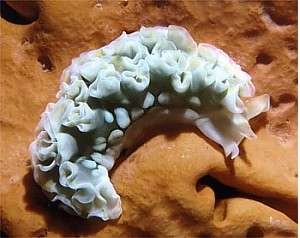
Dear Anne,
Thanks for the great photos. I can see why it is called the 'ruffled sea slug'. I am posting your photos of red-lined animals separately.
Best wishes,
Bill Rudman.
Red-lined form of Tridachia crispata
December 7, 1999
From: Anne Dupont
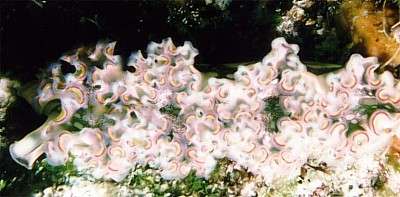
Dear Bill,
Here are two red-lined forms of Tridachia crispata.
UPPER & LOWER RIGHT: Bay Islands, Honduras, Central America. LOWER LEFT: Light Reef Atoll, Belize, Central America.
Anne
adupont@gate.net
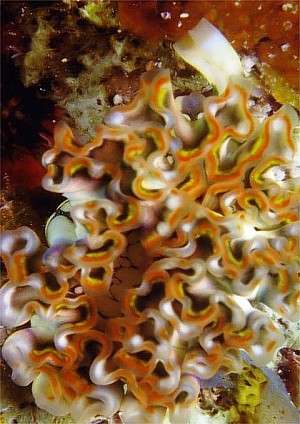
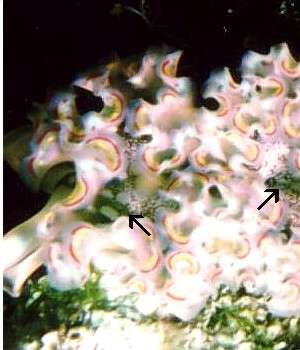
Dear Anne,
Thanks again. I have included an enlargement of the Honduras animal because you can clearly see the green specks which are aggregations of the green chloroplasts I mention at the top of the page .
Best wishes,
Bill Rudman.
